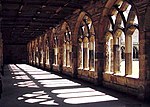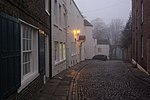Durham University Museum of Archaeology
AC with 0 elementsArchaeological museums in EnglandBuildings and structures of Durham UniversityMuseums in Durham, EnglandMuseums of ancient Rome in the United Kingdom ... and 2 more
University museums in the United KingdomUse British English from August 2015

The Museum of Archaeology, founded in 1833, is a museum of the University of Durham in England. The museum has collections ranging from the prehistoric, Ancient Greece, Roman to Medieval.
Excerpt from the Wikipedia article Durham University Museum of Archaeology (License: CC BY-SA 3.0, Authors, Images).Durham University Museum of Archaeology
The College, Durham Viaduct
Geographical coordinates (GPS) Address Nearby Places Show on map
Geographical coordinates (GPS)
| Latitude | Longitude |
|---|---|
| N 54.773055555556 ° | E -1.5783333333333 ° |
Address
Old Fulling Mill
The College
DH1 3EB Durham, Viaduct
England, United Kingdom
Open on Google Maps









